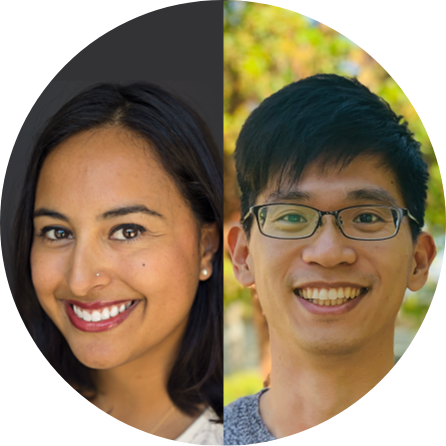Speakers: Ghisly Garcia and Brian Chien
Moderator: Victoria Docherty
Audio recording of the session:
Ghisly Garcia is a first-year master’s student in the Learning, Design, and Technology (LDT) program at Stanford Graduate School of Education. She is also a Senior User Experience Researcher at Google, where she focuses on making communication products easy and delightful to use.
Brian Chen is a first-year master’s student in the Learning, Design, and Technology (LDT) program at Stanford Graduate School of Education. Brian is a software developer aiming to support K-12 education using software. He is passionate about social-emotional learning, human-centered design, and assisting children in learning how to learn.
Central questions:
- What classes did you take this quarter and how have they helped you progress toward your goals?
- What does community building look like in your classes and for your cohort as members of the LDT program?
- What are the must-haves for remote learning and what would you hope instructors would consider when community building in a class?
Key quotes:
Most of us are home right, we’re in a pretty intimate environment. So when you dial in, you see our lives and all the environments around us. One interesting way that we build community is just to kind of bring that environment into the conversation like pets or kids that are around. – Ghisly Garcia (05:59)
I’ve been arranging different events and gatherings with themes and a clear agenda. Sometimes a very limited meeting time as short as 30 minutes, so people don’t feel like they’re obligated to do things. Kind of reduce that feeling and try to mimic the casual encounter that people would have otherwise and it’s been working really great. – Brian Chen (08:21)
I really think the most important thing is just to recognize that students are people just like the professors and the TAs are people and that this is a really, really trying and difficult time. – Ghisly Garcia (16:11)
One key success element would be having the faculty and the students co-creating the classes. Then by using exit tickets on different surveys throughout the course, you can refine or iterate through the style. – Brian Chen (18:10)
Takeaways:
Class structures that help students progress toward personal and professional goals
- Provide various course frameworks and ways of thinking into solving different problems
- Flexibility in choosing projects that relate to student interests and working with others with shared passions
- Remote environments that promote community-building and provide students with multiple opportunities to connect with their cohort
Examples of community building in classes and for members of the LDT program
- Icebreaker activity where students find something in the room to share out with everyone else and explain what is meaningful about that item
- Virtual dinners or picnics with the LDT cohort where everyone ordered the same food dish from different locations and restaurants
- Whatsapp group for students to keep in touch, check-in on each other, and provide updates on classes
- Admin week events and activities to develop connections with deferred, current, and incoming students
- Shared reading list for students to read through, discuss together, and provide different perspectives
Must-haves for remote learning and community building
- Open class with icebreakers where students share their thoughts and create opportunities where the whole class can create something together
- Breakout room group discussions and working directly in pairs, and shifting between lecture and group work
- Be flexible with people and deadlines, and acknowledge the challenges that are arising at this time
- Co-creating classes with the faculty and students, and using exit tickets throughout the course to help improve the class
